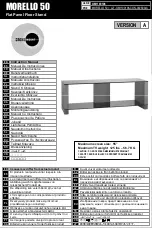
48
Mounting and Operating Instructions CEAG Battery Cabinets
40071860035 (N) March 2016 www.ceag.de
5 Transport, Packaging and Storage
5 Transport, Packaging and Storage
5.1 Safety Notes
WARNING! RISK OF INJURY!
There is a risk of injury when transporting or loading due to
falling parts.
ATTENTION!
DAMAGE TO PROPERTY!
Batteries will be destroyed or damaged by improper trans-
port.
• The following safety notes have to be observed:
• Never lift loads over person`s head.
• Always move battery with great care and attention.
• Only use lifting accessories and hoisting devices with
enough loading capacity.
5.2 Carriage by land of closed lead acid batteries
Monoblocs have to be transported standing upright.
Batteries with no damage do not have to be transported as
hazardous material (In Germany according to ”Hazardous
Material Regulation for Street –ADR- and for Train –RID-“).
They have to be protected against short circuits, slipping,
falling and damage.
Blocs can be stockpiled adequately by securing on the pal-
lets (ADR or RID). It is forbidden to stack one pallet above
the other.
Blocs with leaky or damaged containers have to be packed
and transported as hazardous material of class 8, UN-no.
2794.
5.3 Carriage by sea of closed lead acid batteries
The following type series are not hazardous material ac-
cording to IMDG, because they fulfill the IATA-clause A 67:
Sonnenschein A 400
Marathon
Sprinter
5.4 Carriage by air of closed lead acid batteries
The following type series are not hazardous material accor-
ding to IATA-clause A67:
Sonnenschein A400
Marathon Sprinter
5.5 Abbreviations
ADR:
The European Agreement Concerning the International
Carriage of Dangerous Goods by Road (covering most of
Europe)
RID:
Regulations concerning the International Carriage of
Dangerous Goods by Rail (covering most of Europe, parts
of North Africa and the Middle East)
IMDG:
The International Maritime Dangerous Goods Code
IATA:
The International Air Transportation Association (world-
wide)
ICAO:
Civil Aviation Organization’s Technical Instructions for
the Safe Transport of Dangerous Goods by Air
5.6 Transport Inspection
Check delivery on receipt for completeness and for transport
damages, immediately.
If external damage is detected do not accept the delivery,
except under protest.
5.7 Packaging
If no return – agreement exists for packing material separate
it according to type and size for further use.
ATTENTION!
Packing material has to be recycled in an environmentally
friendly way and according to the local provisions gover-
ning disposal. If necessary, commission special recycling
company.
•
Components will be identified on the basis of number
and type of blocs or on the basis of a battery drawing.
•
It is forbidden to stack one pallet above another.
•
Observe notes for handling printed on the packing
material.
•
Avoid damage during transport for breakable products
by marking them.
5.8 Requirements and Preconditions
Avoid and remove dirt and dust on the surfaces.
The storage location should fulfill the following functions:
•
Shelter the cells / monoblocs from harsh weather and
risk of flooding.
•
Protect the batteries against any overheating risk indu-
ced by direct or indirect exposure to sun radiation.
•
Storage rooms for batteries should be clean, dry, frost-
free and neat.
•
Protect the batteries from any risk of electric shock
resulting from shortcircuiting by metallic items or con-
ductive dust.
•
Avoid any risk caused by dropping objects onto cell /
monoblocs or by dropping the cell / monobloc itself.
5.9 Storage Conditions
•
The temperature has an impact on the self - discharge
rate (see fig. 1 and 2).
•
Storage on a pallet wrapped in plastic material is autho-
rised. It is not recommended however in rooms where
the temperature fluctuates significantly, or if high rela-
tive humidity can cause condensation under the plastic
cover. With time, this condensation can cause a whitish
hydration on the poles and lead to high self-discharge
by leakage current.
•
It is forbidden to stack one pallet above the other













































